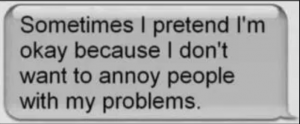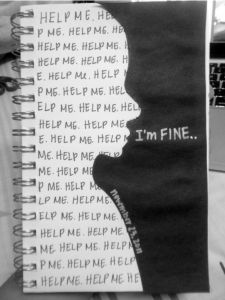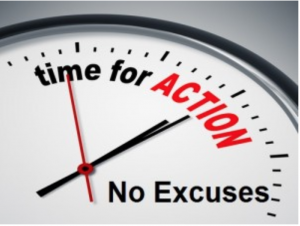Signs of Teenage Suicide
Understanding the causes, symptoms, and signs of teenage suicide is a critical basis for effective action in preventing suicide. Avoiding misperceptions and having accurate data on which to rely also helps to build confidence and a more solid footing. Having access to other resources – from hotlines and videos to websites – can significantly expand the web of support that you can create to help someone with suicidal thoughts.
Causes of Suicide
There are a lot of factors and feelings that can lead a teenager to take his or her life and they often gang up. Some may have been going on for a long time, which can be exhausting. Complicating these factors is the fact that most teenagers considering suicide are suffering from a mood disorder – particularly depression.
Feelings
The mix of possible feelings is impressive, for example:
- Feeling overwhelmed and unable to cope
- Hopelessness
- Anxiety
- Feeling worthless
- Being worn out
- Feeling unconnected
- Feeling like a failure
Contributing Factors
The mix of possible factors leading to suicidal thoughts and actions is also impressive:
- Break-up of friendships
- Divorce of parents
- Violence/abuse in the home
- Inability to find success at school
- Feelings of worthlessness
- Rejection by friends or peers
- Substance abuse
- Death of someone close to the teenager
- The suicide of a friend or someone he or she “knows” online
- A move to a new community/school with trouble connecting
- Rejection by a college
- Being bullied – face-to-face or online
- Serious/chronic illness or serious injury
Depression
If the person is suffering from general depression, these factors are more powerful.

Signs of Suicidal Intent
What is problematic about some of these teenage suicide signs is that
many of them are similar to natural teenage behaviors.
The rollercoaster of the teenage years can easily generate behaviors that look like signs of an intent to be self-destructive. Plus, teenagers are different. Some teenagers can show a number of these signs and not be suicidal. On the other hand, some teenagers will show little and be in extreme danger of suicide.
Don’t Wonder – Ask
If you are unsure about whether someone is thinking of taking their own life – ask them. Let them know you are concerned, that you care and that you are willing to risk their anger rather than leave them unconnected.

Statements – Direct and Indirect
Direct statements are one of the most overlooked signs of teenage suicide. People who talk about suicide, threaten suicide or call suicide crisis lines are 30 times more likely than average to kill themselves. Take suicide threats seriously.
- “I hate my life.”
- “I’d be better off dead.”
- “There is no way out for me”
- “Things will never get better”
- “Nobody will miss me anyway”
- “I won’t be bothering you much longer.”
- ”You’ll be better off without me.”
- “I wish I hadn’t been born”
- “I’m just a burden”
- “No one cares”
- “What’s the point of living anyway?”
- “I am going to kill myself.”
Note. Suicide threats can be spoken, in print (including lots of social network channels), symbolic (for instance drawings or tattoos), etc.
Previous Suicide Attempts
- One out of three suicide deaths is not the individual’s first attempt
- The risk for completing suicide is more than 100 times greater during the first year after an attempt.
Changes in Mood or Behavior
Severe mood and behavioral swings serve as one of the most common signs of teenage suicide. This is one of the potentially confusing areas as a lot of these feelings are a natural part of the rollercoaster of the teenage years. There is no magic advice, unfortunately. Just trust your instincts and if any are particularly intense or become chromic or too many start showing up – ACT.
Mood
- Sudden, abrupt changes in personality
- Expressions of hopelessness and despair
- Increased irritability and aggressiveness
- Listlessness
- Helplessness and hopelessness
- Feeling overwhelmed
- Feelings of loneliness or abandonment
- Feelings of shame, guilt, humiliation or rejection
- Difficulty concentrating, focusing, paying attention
- Lack of interest in activities once enjoyed
- Increased desire to stay home from school
Behaviors
- Self-injury, such as cutting
- Declining grades and school behaviors
- Withdrawal from family, friends and other relationships
- Decreased interest in appearance
- Changes in eating and sleeping habits
- Frequently complaints of being sick, particularly headaches, stomachaches or lack of energy
- Significant weight gain or loss
- Increased use or abuse of alcohol or drugs
- Taking excessive risks, being reckless
- In trouble with the school or the law
- Sudden calm after a period of heavy stress or depression
- Increased interest in guns/knives or gunplay/knifeplay
Preoccupation With Suicide
This is similar to the “statements” section, but worth teasing out. Preoccupation can be evidenced by:
- Frequenting internet sites about suicide or death
- Poems or stories about death, suicide or other dark themes
- Artwork depicting dark themes
- Consistent conversations about dark themes
Making Final Arrangements
If someone is making final arrangements, this is a red flag. Not everyone who decides to commit suicide makes final arrangements, but if someone is doing so – ACT.
- Saying good-bye to family and friends
- Giving away favorite possessions
- Talking about or making funeral arrangements
- Generally putting their affairs in order

Common Misperceptions
“People who talk about suicide won’t really do it.”
False: Almost everyone who attempts or completes suicide has given warning signs through their words or behaviors. Do not ignore any suicide threats. Statements like “You’ll be sorry when I’m dead” or “I wish I was dead” — no matter how casually or jokingly said — may indicate serious suicidal feelings.
“If a person is determined to kill him/herself, nothing is going to stop him/her.”
False: Even the most severely depressed person has mixed feelings about death, wavering until the very last moment between wanting to live and wanting to die. Most suicidal people do not want to die; they want the pain to stop. The impulse to end their life, however overpowering, does not last forever.
“Talking about suicide may give someone the idea.”
False: You do not give a person ideas about suicide by talking about it. The opposite is true. If a person is depressed or unhappy, discussing their feelings openly and allowing them to express how they feel is one of the most helpful things you can do. Even if they have had suicidal thoughts, giving them permission to express those thoughts can relieve some of the anxiety and provide an avenue to recognize other ways to escape their pain and sadness.
“People who attempt suicide and do not complete suicide are just trying to get attention and are not really serious.”
False: To a certain degree, they are trying to get attention and help for the pain that they are experiencing. A suicide attempt, even half-hearted, is an attempt to seek help. If the person perceives their action to be a suicide attempt, then that is what it is. Any attempt, regardless of severity, must be taken seriously and help must be sought for the individual.

What is the Reality? Statistics
There is reasonable agreement on statistics across sources, but the statistics are updated by different sources at different times.
In General
- More than one in every 10 high school students reported having attempted
suicide; nearly 1 in 6 students between the ages of 12-17 have seriously
considered it. - Suicide is the second leading cause of death for ages 10-24 – after unintentional injury
- There are approximately 5500 suicide attempts every day by students in grades 7-12.
- Note. Recent research shows that the suicide rate among 10-14 year olds doubled between 2007 and 2014 – surpassing the death rate from car crashes.
LGBT Youth
- More than 30% of LGBT youth report at least one suicide attempt within the last year.
- More than 50% of Transgender youth will have had at least one suicide attempt by their 20th birthday.
Gender Disparities – All Ages
- Men die by suicide four times as often as women and represent 78.8% of all U.S. suicides.
- Women attempt suicide two to three times as often as men.
Racial and Ethnic Disparities
- The highest suicide rates are among American Indian/Alaskan Natives and Non-Hispanic Whites.
- Asian/Pacific Islanders have the lowest suicide rates among males while Non-Hispanic Blacks have the lowest suicide rate among females.
Lots of Statistics
American Association of Suicidology
http://www.suicidology.org/resources/facts-statistics

Resources – Hotlines/Textlines, Websites & Videos
Hotlines/Textline
There are a number of suicide prevention hotlines out there, but most seem get answered by the National Suicide Prevention Lifeline.
National Suicide Prevention Lifeline: 1-800-273-talk (8255)
(Also the number for the Veterans Crisis Line and takes calls for other hotlines)
Automated beginning to route you to the nearest counselor. It took 2 minutes to get to a counselor
The Trevor Project (LGBT focus): 1-866-488-7386
Answered by a person immediately.
Crisis Text Line
https://www.crisistextline.org/
Text HOME to 741741. This is a text hotline. Automated beginning that will ask for a little information, then connected to a counselor for texting.
Websites
These websites have a great deal of information and guidance and it is laid out very clearly. There is a lot of overlap, but each has its own focus, so look at several.
Links may go bad over time, so please let me know if you find a bad link.
HelpGuide.org
Excellent site with lots of clear information, guidance and resources
Suicide Prevention
http://www.helpguide.org/articles/suicide-prevention/suicide-prevention-helping-someone-who-is-suicidal.htm
If You Are Feeling Suicidal
http://www.helpguide.org/articles/suicide-prevention/suicide-help-dealing-with-your-suicidal-thoughts-and-feelings.htm
Metanoia
This links directly to a very personal “letter” to a suicidal person. The style and guidance are excellent. Some of the resources noted may be out of date.
https://metanoia.org/suicide/spagebw.htm
The Jason Foundation
Lots of information laid out clearly
American Foundation for Suicide Prevention
Another big site with a lot of information
Suicide Prevention Resource Center
Big site with lots of information. Looks at the scope of the problem and different populations (men, women, teens, by race, LGBT, etc.)
Videos
The videos take a more personal look at teenage suicide signs as well as suicide in general, often with the voices of teens.
Mayo Clinic
“In this video created by Mayo Clinic, teens describe common signs that a teen is considering suicide and provide encouragement for communicating directly and immediately for support and safety. It also Includes suggestions for what to say to a teen who may be at risk for suicide and ways to keep them safe.”
Teens doing the talking. 4 minutes
Jordan Burnham suicide attempt at 16
Powerful story told by Jordan Burnham. 11 minutes
http://www.suicidepreventionlifeline.org/learn/video.aspx?vid=EBS0YggSTTo
The Truth About Suicide on College Campuses
College students talking about their experience. Lots of insights. 12.5 minutes
Breckenridge High School Students
This is the full-length version of the Breckenridge High School video that won the Minnesota State Suicide Prevention Student Video competition. Powerful soundtrack and good story of a suicidal girl and her friends. 5.5 minutes
Sadie Penn TED-X talk – her suicide attempt
Sadie Penn is a suicide survivor and is now an advocate of suicide prevention. She feels it’s time to talk about the struggle and get it out in the open. Direct messages for teens feeling suicidal and those that might help. 12 minutes
American Association of Suicidology
List of videos for purchase related to suicide
This Site & the Larger Support Network
This site is not a substitute for emergency services, therapy, counseling or other sources of support. The more resources that can be brought to bear, the better.
The site can be part of the network you rely on for supporting a suicidal friend or family member, but you need to add as many elements to the network as possible – supporting you and your friend or family member
The more resources that can be added to their support network – particularly over time – the better. Take advantage of the resources offered here, but also think about connections that can be made in school, faith communities, community organizations, online support groups, the neighborhood, extended family, etc.
